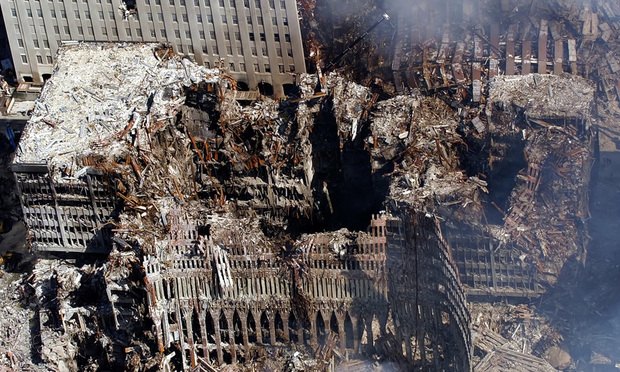 Photo: Eric J. Tilford
Photo: Eric J. Tilford
On the 18th anniversary of the September 11, 2001, terrorattacks, the world remembers and mourns the 2,977 lives lost thatday.
|In addition to the immeasurable human costof the deadliest terrorist attack in U.S. history, 9/11also had a far-reaching economic impact on U.S. marketsand businesses—especially the insurance industry.
|Government estimates price property damage alone at about $100billion. Other estimates of the total economic damage inflicted bythe attacks range from $2 trillion to $3.3 trillion.
|The InsuranceInformation Institute (III) estimates insurance losses from the9/11 attacks, which remains history's most expensive terroristincident, at approximately $47 billion in 2019dollars.
|Before 9/11, commercial insurers often neither charged for norspecifically excluded terrorism coverage. U.S.-based andinternational insurers were able to pay virtually all of the claimsrelated to 9/11, but the eventand its $47 billion cost demonstratedto insurers that if another terrorist attack wereto occur, the industry could not cover those losses on its own.
||
Congress Responds with TRIA
Addressing the insurance industry's concerns, Congress enactedthe Terrorism Risk Insurance Act of 2002 (TRIA), which created afederal backstop for insurance claims related to acts ofterrorism, requiring that business insurers offerterrorism coverage for the types of insurance included in the act.TRIA provides for a transparent system of shared publicand private compensation for insured losses resulting from acts ofterrorism, designed to keep terrorism risk insurance available andaffordable.
|TRIA was renewed three times—in 2005, 2007, and 2015.It is currently set to expire on December 31, 2020. While that isstill a year away, commercial insurers are concerned andpreparing for a market without TRIA. They also are warningofficials about the consequences of inaction.
||
What Happens If TRIA Expires?
A newly published white paper from III, "A World Without TRIA: Incalculable Risk,"outlines TRIA's history and impact, and explains what could happenif TRIA is allowed to expire on December 31, 2020.
|To get an idea of what a world without TRIA would look like, IIIexamined two periods post-9/11 when there was no federalbackstop for terrorism insurance.
|First, during the period immediately after the attacks, themarket for terrorism risk insurance contracted severely and hadpotentially wide-reaching effects on the U.S. economy, the IIIpaper explains.
|Second, in 2015, TRIA lapsed for two weeks after Congress failedto reauthorize the act before it expired on December 31, 2014. Themarket remained stable since the lapse was so short, but some saythe longer the lapse would have lasted, the more the market wouldhave been affected, particularly for workers' compensation.
|During that lapse, the Congressional Budget Office (CBO)published a report that examined possible consequences if thebackstop were to not return. In the report, theCBO concludes that "the private market would notexpand to fully offset the loss of federal reinsurance" and citesthe difficulties in pricing terrorism risk. Outlining the impactson insureds, the CBO report predicts that consumers would havefewer insurers to choose from, their premiums would be higher, andcoverage limits would be lower.
|Additionally, the report concludes, "The effects onpolicyholders will probably be felt more acutely in high-riskareas, and economic activity (particularly construction) in suchareas may be reduced."
||
The Future of TRIA and TRIP
Looking at 2021, the future of TRIA is uncertain, asis how the marketplace might change if theprogram were to expire on December 31, 2020. Whatis certain is that failure to reauthorize TRIA would causesignificant disruption.
|III's white paper notes, "Uncertainty around the future of TRIPimposes costs on its own, as insurers and reinsurers begin torenegotiate with the possibility that TRIP may not bere-authorized. Acts of terror are unpredictable. Uncertaintyregarding government support and the regulatory environmentcomplicates the issue."
||
From: PropertyCasualty360
Complete your profile to continue reading and get FREE access to Treasury & Risk, part of your ALM digital membership.
Your access to unlimited Treasury & Risk content isn’t changing.
Once you are an ALM digital member, you’ll receive:
- Critical Treasury & Risk information including in-depth analysis of treasury and finance best practices, case studies with corporate innovators, informative newsletters, educational webcasts and videos, and resources from industry leaders.
- Exclusive discounts on ALM and Treasury & Risk events.
- Access to other award-winning ALM websites including PropertyCasualty360.com and Law.com.
*May exclude premium content
Already have an account? Sign In
© 2024 ALM Global, LLC, All Rights Reserved. Request academic re-use from www.copyright.com. All other uses, submit a request to [email protected]. For more information visit Asset & Logo Licensing.







